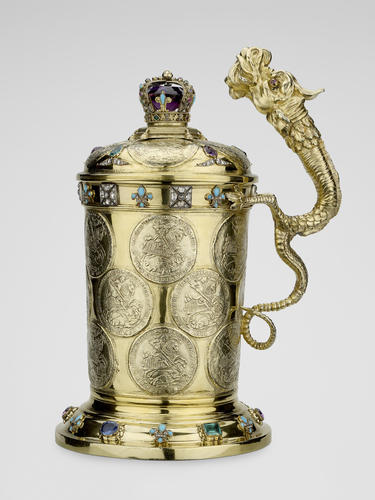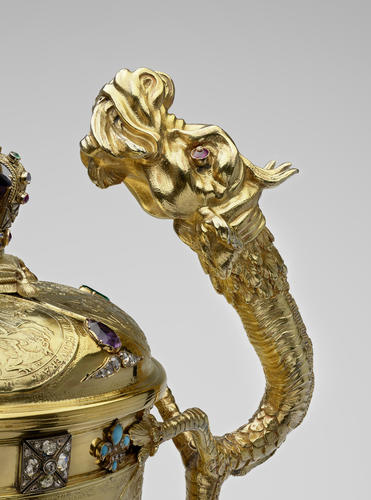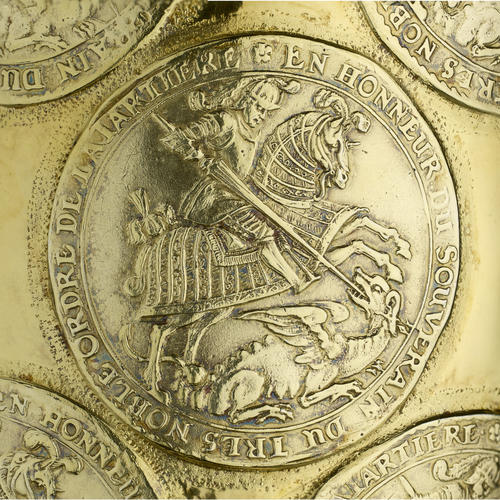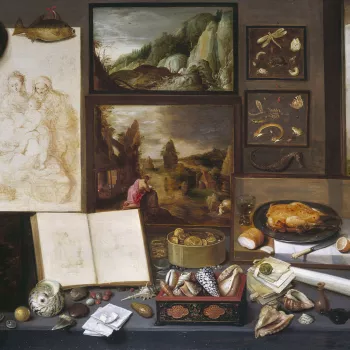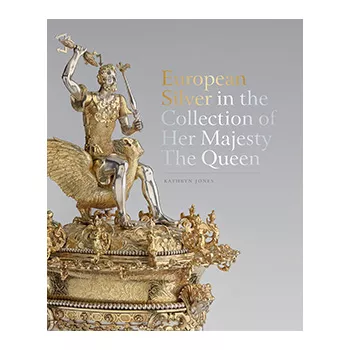Tankard c.1678
Silver gilt, amethyst, diamond, sapphire, pink sapphire, emerald, turquoise, enamel | 29.0 x 20.0 x 15.8 cm (whole object) | RCIN 50602
-
A silver-gilt tankard and cover inset with five taler coins of St George and the dragon. The finial is cast as the Imperial State Crown, with the cap of maintenance formed from a large facet-cut amethyst. The tapering, straight-sided body has an elaborately cast handle in the form of a dragon with ruby eyes (with diamond pupils) and diamond-mounted fangs. It is inlaid with talers, between borders of gemstones (emerald, ruby and sapphire) and enamelled fleurs-de-lis in turquoises and diamonds.
The base of the tankard is inset with a taler, and the rim engraved with a Royal crest and Garter.
Tankards inset with coins were typically produced in northern Germany, but the inset jewels and extremely unusual handle are far from typical. It makes use of the taler coins produced in 1678 by the Dresden mint, in honour of the great festival held on 23 April that year in the city by Johann Georg II of Saxony. The Elector was installed as a Garter Knight on 29 May 1671, but had pre-empted the official ceremony with a celebration on St George's Day. In the subsequent years of his reign, on the anniversary of the first festivities, further celebrations were held. The day became an excuse for Lutheran propaganda with Johann Georg as its champion. In 1678 the Elector commissioned the new talers to coincide with the celebrations.
The dragon handle ties the tankard to the legend of St George, but the form is unusual; the dragon is wingless and has a highly tapered body and only two legs. It may relate to images of dragons on Chinese porcelain, although the legend of a wingless dragon or lindworm was also known throughout the regions of Germany.
The tankard came from the collection of Frederick, Duke of York, although when it was sold at auction after his death, it was described as only partly gilded, and no mention was made of the additional gemstones or of the crown finial. The crown represents the Imperial State Crown of England and must have been a later addition to the seventeenth-century tankard. It is likely that the additional gemstones and enamelled fleurs de lis were also added when the piece was acquired by George IV and that the piece was gilded all over at the same time.
Marked on rim of cushion, but worn; scratch on base, 7056; engraved on rim with royal crest and crowned Garter.
Coins: Johann Georg II, Elector of Saxony (1613-80): taler (1678), Dresden mint. Coins struck: DU TRE HAUT / TRE PUISSANT ET / TRES EXCELLENT PRIN / CE CHARLES II PAR LA / GRACE DE DIEU ROY DE / LA GRANDE BRETAG: / FRAN: ET IRELANDE DE / FENSEUR DE LA FOY. / MDCLXXVIII; struck on obverse: EN HONNEUR DE SOUVERAIN DU TRES NOBLE ORDRE DE LA IARTIERE.Provenance
Frederick, Duke of York; sold Christie's, London, York sale, 1827 (day 4, lot 29; purchased by Rundell's for £57 15s); purchased by George IV from Rundell, Bridge and Rundell in 1827, for £294 2s 6d.
-
Creator(s)
(nationality)Acquirer(s)




